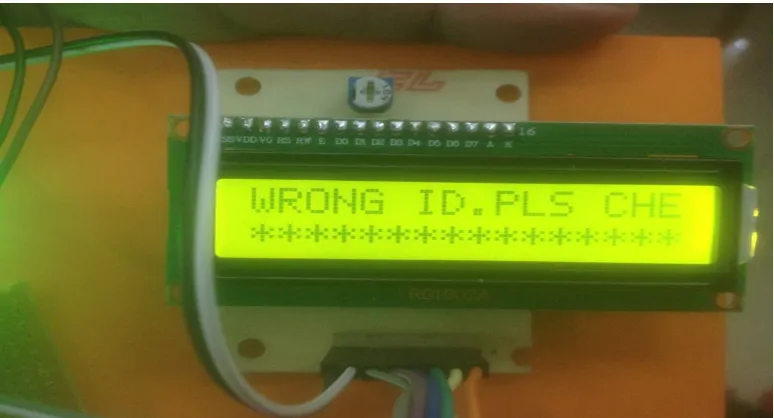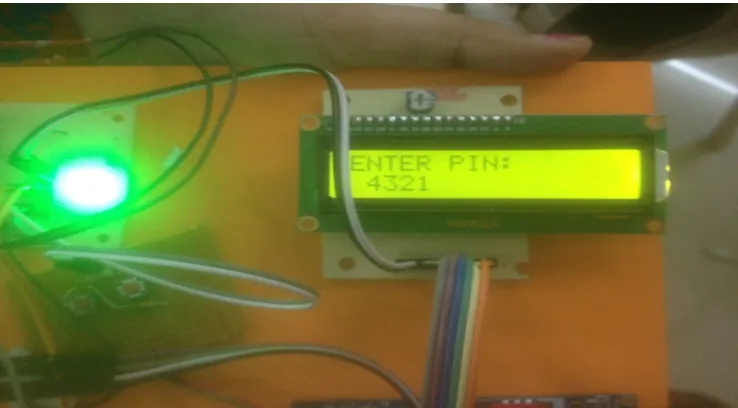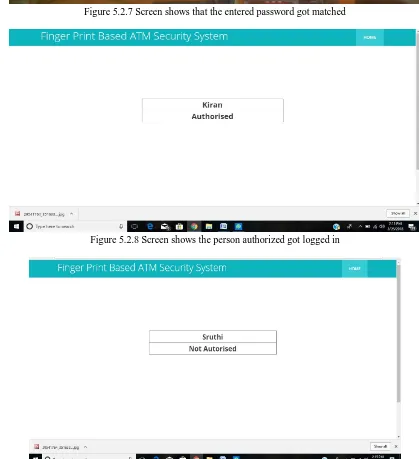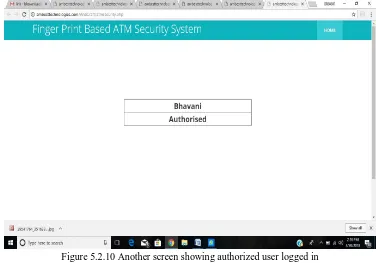International Journal for Research in Applied Science & Engineering Technology (IJRASET)
ISSN: 2321-9653; IC Value: 45.98; SJ Impact Factor: 6.887 Volume 6 Issue V, May 2018- Available at www.ijraset.com
Security Authentication based Fingerprint on
ATM
U Bhavani1, S Lakshmi Sruthi2, P Kiran Kumar3
1Student , Vignan Institute of Technology and Science, Hyderabad
2Student, Vignan Institute of Technology and Science, Hyderabad
3Associate Professor, Vignan Institute of Technology and Science, Hyderabad
Abstract: Fingerprint Based ATM is a desktop application where fingerprint of the user is used as a authentication. The finger print minutiae features are different for each human being so the user can be identified uniquely. Instead of using ATM card Fingerprint based ATM is safer and secure. There is no worry of losing ATM card and no need to carry ATM card in your wallet. You just have to use your fingerprint in order to do any banking transaction. The user has to login using his fingerprint and he has to enter the pin code in order to do further transaction. The user can withdraw money from his account. User can transfer money to various accounts by mentioning account number.
Keywords: Security, ATM, Biometric (Fingerprint), Crime, Verification
I. INTRODUCTION
Biometrics are automated methods of recognizing a person based on a physiological or behavioral characteristic. Biometric-based solutions are able to provide for confidential financial transactions and personal data privacy. The various features used are face, fingerprints, hand geometry, handwriting, iris, retina, vein and voice [1]. Fingerprinting or finger-scanning technologies are the oldest of the biometric sciences and utilize distinctive features of the fingerprint to identify or verify the identity of individuals. Finger-scan technology is the most commonly deployed biometric technology, used in a broad range of physical access and logical access applications. All fingerprints have unique characteristics and patterns. A normal fingerprint pattern is made up of lines and spaces. These lines are called ridges while the spaces between the ridges are called valleys. It is through the pattern of these ridges and valleys that a unique fingerprint is matched for verification and authorization. These unique fingerprint traits are termed “minutiae” and comparisons are made based on these traits [2]. On average, a typical live scan produces 40 “minutiae”. The Federal Bureau of Investigation (FBI) has reported that no more than 8 common minutiae can be shared by two individuals.
II. RELATED WORK
The design of algorithm based on fingerprint recognition is so vital for the whole system. We would approach two steps to process the images of fingerprint.
A. The detail of fingerprint recognition process.
The first step was the acquisition of fingerprint image by above device mentioned in the algorithm, and the results could be sent to the following process. secondly, pre-processing the images acquired. After obtain the fingerprint image, it must be pre-processing. Generally, pre-processing of one's is filtering, histogram computing, image enhancement and image binarization. Lastly, the characteristic value was extracted, and the results of the above measures would be compared with the information of owner's fingerprint in the database so as to verify whether the character is matched, and then the system returned the results matched or not.
B. The design of fingerprint image enhancement
III. METHODOLOGY
The embedded ATM client authentication system is based on fingerprint recognition which is designed after analyzed existed ATM system. The S3C2440 chip is used as the core of these embedded system which is associated with the technologies of fingerprint recognition and current high speed network communication.
The primary functions are shown as follows: • Fingerprint recognition: The masters' fingerprint information was used as the standards of identification. It must certify the feature of the human fingerprint before using ATM system. • Remote authentication: System can compare current client's fingerprint information with remote fingerprint data server. • Message alarming: different 4-digit code as a message to the mobile of the authorized customer without any noise, in order to access the Terminal. • Two discriminate analysis methods: Besides the fingerprint recognition, the mode of password recognition can be also used for the system
IV. IMPLEMENTATION
The fingerprint based ATM authentication system is designed such that the door access can be controlled using fingerprint authentication. The status of the door access is displayed on the LCD. The complete schematic
The schematic depicts the interfacing of each component with microcontroller and input output modules. The experimental setup of the fingerprint based ATM authentication system
International Journal for Research in Applied Science & Engineering Technology (IJRASET)
ISSN: 2321-9653; IC Value: 45.98; SJ Impact Factor: 6.887 Volume 6 Issue V, May 2018- Available at www.ijraset.com
V. RESULTS
[image:3.612.130.483.83.282.2]Figure 5.2.1 Screen shows that the LCD displaying to put finger on the Biometric scanner to capture the image.
[image:3.612.113.500.510.719.2]Figure 5.2.2 Screens showing that the authentication failure message when we give invalid input.
Figure 5.2.4 Screen shows the message notifying about finger enrollment
Figure 5.2.5 Screen shows that the id got stored successfully.
[image:4.612.123.492.507.711.2]International Journal for Research in Applied Science & Engineering Technology (IJRASET)
[image:5.612.102.511.77.260.2]ISSN: 2321-9653; IC Value: 45.98; SJ Impact Factor: 6.887 Volume 6 Issue V, May 2018- Available at www.ijraset.com
[image:5.612.91.510.257.716.2]Figure 5.2.7 Screen shows that the entered password got matched
Figure 5.2.8 Screen shows the person authorized got logged in
[image:5.612.105.493.508.722.2]Figure 5.2.10 Another screen showing authorized user logged in
VI. CONCLUSION
The paper presented a prototype design of an ATM access system using finger print technology. The system consists of finger print module, DC motor, LCD display. These are interfaced to the PIC microcontroller. When a user registers his fingerprint to the finger print module, this is fed as input to the microcontroller. The micro controller is programmed in such a way that the input from the user is checked compared with user database and displays the relevant information on the LCD display. When a authorized person is recognized using finger print module the door is accessed using DC motor. Finger-scan technology is being used throughout the world and provides an able solution. In the present days it is being used for computer network access and entry devices for building door locks. Fingerprint readers are being used by banks for ATM authorization and are becoming more common at grocery stores where they are utilized to automatically recognize a registered customer and bill their credit card or debit account. Finger-scanning technology is being used in a novel way at some places where cafeteria purchases are supported by a federal subsidized meal program. The system can be extended using a GSM module. The GSM module sends alert messages to the respective authorities when unauthorized person’s finger print is detected.
REFERENCES [1] "The 8051 Microcontroller Architecture, Programming & Applications" By Kenneth J Ayala.
[2] "The 8051 Microcontroller & Embedded Systems" by Mohammed Ali Mazidi and Janice Gillispie Mazidi [3] "Power Electronics” by M D Singh and K B Khanchanda
[4] "Linear Integrated Circuits” by D Roy Choudary & Shail Jain [5] "Electrical Machines” by S K Bhattacharya
[6] "Electrical Machines II” by B L Thereja
[7] www.8051freeprojectsinfo.com
[8] Lin Hong, Wan Yifei, Anil Jain. Fingerprint image enhancement: algorithm and performance evaluation[J]. IEEE Transactions on Pattern Analysis and Machine intelligence. 1998,20(8): 777-789.
[9] ESaatci, V Tavsanogh. Fingerprint image enhancement using CNN gabor-Cpe filter[C]. Proceedings of the 7th IEEE International Workshop on Cellular Neural Networks and their Applications 2002: 377-382.



